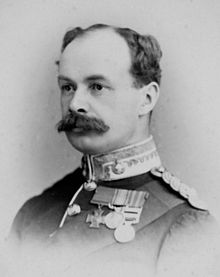Loading AI tools
Recipient of the Victoria Cross From Wikipedia, the free encyclopedia
Alan Richard Hill later Hill-Walker, VC (born Northallerton 12 July 1859 – 21 April 1944) was an English recipient of the Victoria Cross, the highest and most prestigious award for gallantry in the face of the enemy that can be awarded to British and Commonwealth forces. He won the VC for his actions on 28 January 1881 at the Battle of Laing's Nek during the First Boer War.
This article includes a list of general references, but it lacks sufficient corresponding inline citations. (December 2020) |
Alan Richard Hill-Walker | |
|---|---|
 | |
| Born | 12 July 1859 Northallerton, North Yorkshire |
| Died | 21 April 1944 (aged 84) Thirsk, North Yorkshire |
| Buried | St Michael and All Angels Churchyard, Maunby, North Yorkshire |
| Allegiance | |
| Service | |
| Years of service | Retired 12 October 1901 |
| Rank | Major |
| Unit | North Yorkshire Militia 58th Regiment of Foot The Northamptonshire Regiment |
| Battles / wars | Anglo-Zulu War First Boer War Tirah Campaign |
| Awards | |
After his marriage in 1902, he adopted the surname Hill-Walker.[1]
Alan Richard Hill was the son of Captain Thomas Hill, chief constable of the North Riding of Yorkshire Constabulary and Frances Mirriam, daughter of Thomas Walker. He was educated at Richmond Grammar School.
Hill was commissioned in July 1876 as a sub-lieutenant in the North York Rifle Militia.[2] He transferred to the 58th (Rutlandshire) Regiment of Foot in February 1879. The regiment was deployed to South Africa in 1879 for service in the Anglo-Zulu War and he saw action at the Battle of Ulundi in July 1879.

Hill was 21 years old, and a lieutenant in the 58th (Rutlandshire) Regiment of Foot (which had become the 2nd Battalion, The Northamptonshire Regiment under the Childers Reforms by the time the award was gazetted), British Army during the First Boer War when the following deed took place on 28 January 1881 at the Battle of Laing's Nek, South Africa, for which he was awarded the VC.
The citation reads; "For gallant conduct at the action of Laing's Nek on the 28th January, 1881, in having, after the retreat was ordered, remained behind and endeavoured to carry out of action Lieutenant Baillie, of the same Corps, who was lying on the ground severely wounded. Being unable to lift that officer into the saddle, he carried him in his arms until Lieutenant Baillie was shot dead. Lieutenant Hill then brought a wounded man out of action on his horse, after which he returned and rescued another. All these acts being performed under a heavy fire."[4]
Laing's Nek was the last occasion that a British regiment carried its colours into action. The 58th were led up the hillside by Lieutenant Lancelot Baillie carrying the Regimental Colour and Hill carrying the Queen's Colour. Baillie was mortally wounded. Hill passed the two colours to Sergeant Budstock for safe keeping.
He was adjutant of the 3rd and 4th battalions from October 1887 and achieved the rank of major before he retired from the army in October 1901.
In April 1902 he married, in London, Muriel Lilias Oliphant Walker (1876–1953), daughter of T. S. Walker, of Maunby Hall, Thirsk, Yorkshire.[5] He changed his name to Hill-Walker. There were two sons:
Hill's medals were bought in 2015 by the Ashcroft Trust and are displayed in the Imperial War Museum.
Seamless Wikipedia browsing. On steroids.
Every time you click a link to Wikipedia, Wiktionary or Wikiquote in your browser's search results, it will show the modern Wikiwand interface.
Wikiwand extension is a five stars, simple, with minimum permission required to keep your browsing private, safe and transparent.